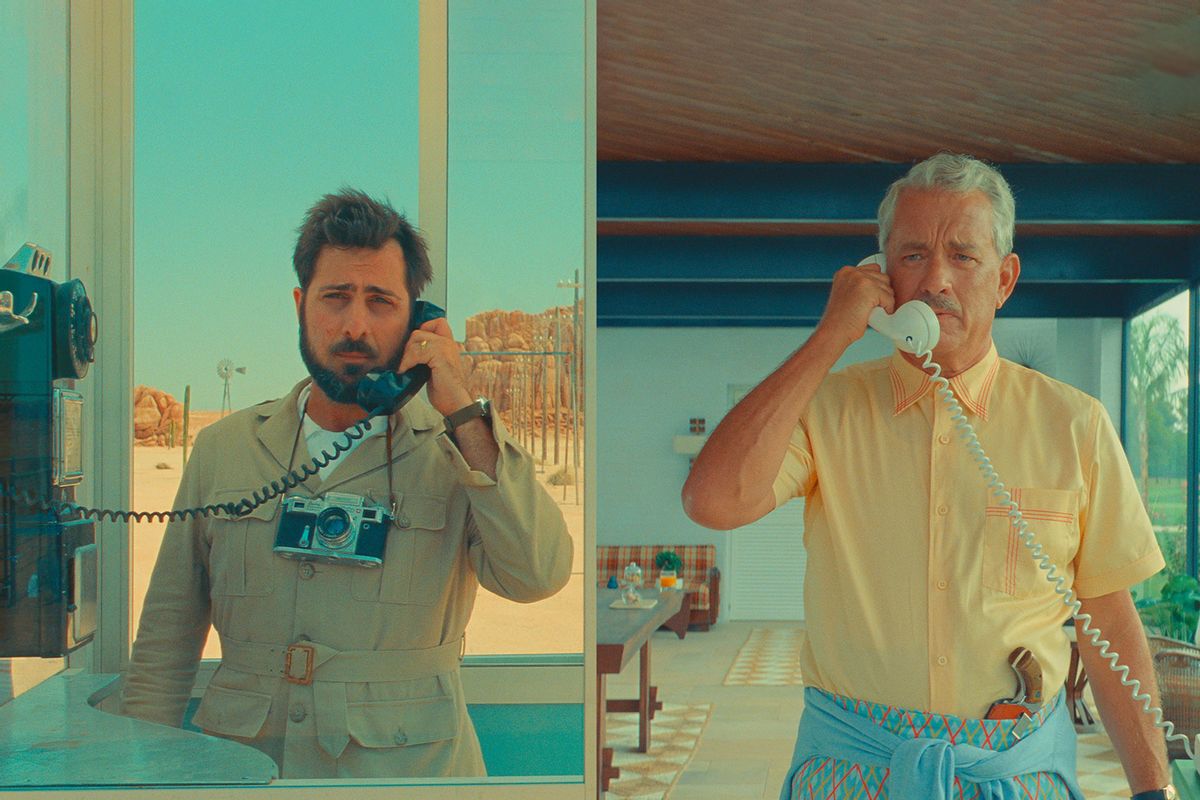Love and loss in “Asteroid City”: Wes Anderson’s intoxicating alien-invasion meta-movie

Every Wes Anderson film is about grief and loss — about the unrecoverable loss of a parent, a child, a sibling, a lover and so on, and even more than that about the loss of childhood itself and the inevitable heartbreak that occurs within families, either the ones we are born into or the ones we gather or accumulate around us. I don’t know what specific losses may have occurred in Anderson’s life, but nothing could possibly be a more universal human experience. For a director who is sometimes lazily understood as being uninterested in human emotion, or only able to approach it through ironic artifice, the consistency of his tragic vision is remarkable.
Wes Anderson emerged from the pandemic and decided he was going to make an arthouse movie, goddammit, and undoubtedly it’s not for everyone, blah blah blah.
“Asteroid City,” which I believe is Anderson’s 11th feature as a director, contains not one but two scenes in which a heartbroken husband has a conversation with his dead wife. In another kind of film by another kind of filmmaker, this might be the ultimate moment of emotional catharsis or breakthrough, wrought for maximum soaked-hanky pathos. So in a sense it is here — I, at least, found the second of those scenes profoundly moving. It delivers a potent emotional wallop almost out of nowhere and also delivers the solution, or resolution, to the convoluted puzzle-box structure of “Asteroid City,” which is without any serious doubt the most ambitious (deadly word!) and most challenging (even worse!) movie Anderson has ever made.
How can such a scene possibly happen twice? Well I don’t want to give the whole damn thing away, of course, but in neither case is it “really” happening, if there can be said to be a plane of fundamental narrative reality at any level of “Asteroid City.” (Which basically there can’t.) In the first instance, Augie Steenbeck (played by Jason Schwartzman), who is indeed a recently bereaved husband and is not dealing with it well, or basically at all, is leaning out the window of a trailer, helping a movie actress in the next trailer named Midge Campbell (Scarlett Johansson) rehearse a scene in which her character has taken sleeping pills and died in the bathtub but is somehow, as a dramatic contrivance, still able to conduct a dialogue.
But the second time around — well, it’s still Schwartzman, no longer playing Augie but instead playing the actor who is playing Augie in the 1950-something New York production of a play called “Asteroid City,” which both is and is not the same as the colorful story involving Augie and Midge and a bunch of other misfit characters that we see unfold in a conspicuously fake town in the “California-Nevada-Arizona desert.” From a balcony above a conspicuously fake Manhattan street, Schwartzman-as-actor has a conversation with another actor who was going to play his wife but — listen, Jesus, it’s absolutely brilliant. I can respect the fact that some or many viewers will be alienated or confused or simply bored by the circuitous journey that’s required to get to that balcony scene. Wes Anderson emerged from the pandemic and decided he was going to make an arthouse movie, goddammit, and undoubtedly it’s not for everyone, blah blah blah. But I’m here to tell you it’s a flat-out tour de force, and that scene made the whole thing worth it.
The thing is, Wes Anderson’s films aren’t just fables about grief and loss; they’re also self-aware stories about storytelling — a dynamic pushed beyond the top of the dial in “Asteroid City.” Some people find that irritating or affected or twee, I guess, and certainly when his work fails to connect it can deliver that effect. But it’s not like he adopted some newly concocted “postmodern” or “ironic” approach to narrative that violates the Ten Commandments of how movies are supposed to be made.
Want a daily wrap-up of all the news and commentary Salon has to offer? Subscribe to our morning newsletter, Crash Course.
Look, all narratives are artificial constructs — or simulations, to use a more contemporary term. Some kinds of simulations demand that we pretend they’re not simulations, in the interest of supposed transparency or “realism.” For Anderson, I suspect, that’s an unacceptable compromise that dulls the story’s power rather than sharpening it. (He’s got a point: Almost nothing is more boring than “humanist” or ultra-realist independent film, unless the execution is superb.) When his films call attention to their artifice, whether through frame-breaking narration, confectionery sets and costuming or deliberately sophomoric absurdism — the fictional Asteroid City features part of a mistakenly constructed freeway overpass, abandoned but not demolished — they refer back to venerable storytelling conventions that long predate the studied psychological realism of mainstream cinema.
If ever there was a movie where our civilization’s first encounter with extraterrestrial life could be treated as an afterthought, this one is it.
It’s customary for critics to labor toward some metaphor for describing Anderson’s films, which have been compared — often explicitly, within the films themselves — to miniatures or dollhouses or bakery cakes or the illustrations in children’s books. They are transparently not attempts to depict the real world (whatever that is, and however one does that) but rather to encode it or enfold it or distill it into a colorful or comical or whimsical construction that focuses our attention in a different way than supposed straightforward naturalism does. I think the best answer is they’re a lot like fairy tales, which are always aware of their status as stories, generally include heroes and monsters and lovers and children and unexplained magical transformations, and typically conclude with a moral lesson, as Anderson’s films almost invariably do.
If my discussion of “Asteroid City” so far has left you wondering, for instance, when and where this movie is set and what the hell it’s actually about — well, yeah. Anderson has unplugged this particular fairy tale from those questions, and if you’re going to enjoy the ride you’ll have to take the experience as it comes. Officially, the framing device here is a ’50s TV documentary (narrated by Brian Cranston), in black-and-white, recounting the strange saga of Wyoming-born playwright Conrad Earp (Edward Norton) and the creation of his unlikely Broadway hit “Asteroid City.” But we hardly spend any time on that level, even though, as I suggested above, it’s crucial to Anderson’s design.
From there we go into the play itself, directed by the hunky but lovelorn Schubert Green (Adrien Brody, doing an Actors’ Studio type), and then, through some kind of narrative transmigration, into — what, the movie of the play? Or just the movie we thought we were already watching? Anyway, into a full-color but still ostentatiously theatrical desert landscape where Augie and Midge and a gaggle of middle-school science geeks get stuck in a mash-up of Wes Anderson themes and moments. There’s an incredibly nerdy memory game, a hapless scientist played by Tilda Swinton, a lovely cameo by Tom Hanks as a character we expect to be loathsome but totally isn’t, an irrelevant side romance (seemingly imported intact from a period musical) between a prim schoolteacher who longs for romance and a rough-around-the-edges cowhand who’s as good as gold. Oh yeah, and an alien invasion. If ever there was a movie where our civilization’s first encounter with extraterrestrial life could be treated as an afterthought, this one is it.
I have no doubt some viewers will experience “Asteroid City” as a maddening Russian doll nested with clever but pointless gags, or as arbitrary and formless. Obviously I don’t agree; I feel confident it’s a film whose structural complexity is integral to its purpose, and one that will reward repeat viewings. All of Anderson’s work, pretty much, is a quest to recover or rediscover the redemptive power of art in an age of permanent dislocation and damaged attention spans, when we are barraged with ineptly crafted pseudo-reality and patently false emotion. That may be a hopeless task, but his case is compelling: The stories we tell are made up, and we can’t be quite sure we are not fictional characters. On the other side of that understanding lies love, loss, pain, life.
“Asteroid City” is now in theaters.
Read more
about this topic


